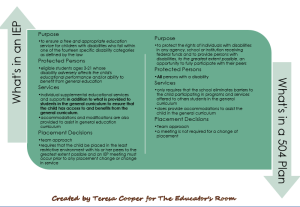 As a special education teacher, it seems that this topic comes up a lot. Inquiring minds want to know…when deciding what’s best for your child, which plan do you go with? Does it matter whether your child has an Individualized Educational Program (IEP) or a 504 Plan? And what do those words really even mean? If I were on the outside looking in and someone asked me which plan to choose in the epic battle of IEP vs 504 Plan, would I know? Most people know that both plans do something to help children in the classroom, but they struggle to pinpoint the differences.
As a special education teacher, it seems that this topic comes up a lot. Inquiring minds want to know…when deciding what’s best for your child, which plan do you go with? Does it matter whether your child has an Individualized Educational Program (IEP) or a 504 Plan? And what do those words really even mean? If I were on the outside looking in and someone asked me which plan to choose in the epic battle of IEP vs 504 Plan, would I know? Most people know that both plans do something to help children in the classroom, but they struggle to pinpoint the differences.
So, what’s the difference?
To start with, even the purposes of the two programs differ. The purpose of an IEP is to ensure a free and appropriate education service for children with disabilities who fall within one of the fourteen specific disability categories as defined by the law. If you look at a 504 plan, though, you’ll see a much broader purpose because the 504 plan comes from a civil rights law meant to protect the rights of individuals with disabilities in any agency, school or institution receiving federal funds and to provide persons with disabilities, to the greatest extent possible, an opportunity to fully participate with their peers. So an IEP ensures a free and appropriate education service, and a 504 plan protects a students opportunities to participate to the greatest extent possible. How you choose to interpret the wording of either of those plans…well, that’s up to you.
Protected Persons – Under an IEP, eligible students ages 3-21 whose disability adversely affects the child’s educational performance and/or ability to benefit from general education get covered under the plan. A 504 plan covers all persons with a disability from discrimination in educational settings based solely on their disability. In order words, in order to receive an IEP, the disability alone would not necessitate the development of the plan. The team would have to show proof that the disability either has a negative impact on the child’s educational performance or hinders the child’s ability to benefit from general education (and some people forget about the second part when considering eligibility, so careful consideration of both factors should occur during the referral process). However, in order to receive a 504 Plan, a student would only need to provide proof of a disability.
Services – You’ll see a majority of the differences in this area, as an IEP provides individual supplemental educational services and supports in addition to what is provided to students in the general curriculum to ensure that the child has access to and benefits from the general curriculum. These services get provided free of charge to the parent. A 504 plan only requires that the school eliminates barriers to the child participating in programs and services offered to others students in the general curriculum. Whereas a 504 Plan does provide accommodations to assist the child in the general curriculum so that the child has barriers removed in the classroom and this does require a documented plan be put in place, the plan must remain comparable to that of general education students. An IEP must include specific content addressing the disability directly and specifying educational services to be delivered, mandating transition planning for students 16 and over, as well as a Behavior Intervention Plan for any child with a disability that has a behavioral issue. “Appropriate Education” is defined as a program reasonably calculated to provide “educational benefit” to the student. Related services also become part of the IEP as needed for the student to benefit from the educational process and should go along with specially designed instruction (e.g., counseling, speech, transportation, occupational and physical therapy, etc.).These services only get provided for students once an IEP becomes part of their educational plan, as these services go outside the scope of what most general education students receive.
Placement Decisions – To make decisions about a child for an IEP, the team must use documentation and use a team approach to make eligibility decisions. Team members must be knowledgeable about the child, able to interpret evaluation data, and the continuum of services and placement available for the child. An IEP requires that the child be placed in the least restrictive environment with his or her peers to the greatest extent possible and an IEP meeting must occur prior to any placement change or change in service. With an IEP, students remain eligible for a full continuum of placement options including regular education with related services as needed. To make decisions about a child with a 504 plan, the team approach, knowledge about the child, evaluation data, and continuum of services is still required. The student must still receive a free and appropriate education with his/her non-disabled peers. However, a meeting is not required for a change of placement. Students are served in general education with or without modification. Possible accommodations under a 504 plan could be: structured learning environments, repeated or simplified instructions, behavior intervention strategies, modified testing procedures, modified or adjusted homework, textbooks on top, etc. (any accommodations or modifications used on an IEP may also get included with a 504 plan).
Of course, these comparisons only provide you with a shortened version of how these two plans may be separated. They also differ in how you can file complaints, the safeguard procedures, and many other ways.
For more information, please visit these two websites:
- Individuals with Disability Education Improvement Act (IDEA)
- Section 504 of the Rehabilitation Act of 1973





